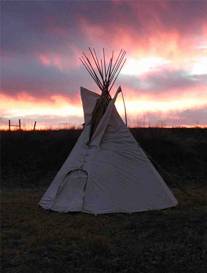Subject Guide

Mountain West
Malachite’s Big Hole
Reenacting - Shelter:
Although the Mountain Man typically did not bother with setting up shelter during times of good weather, or when on the move, modern convention places greater demands for privacy. Types of shelters generally seen and accepted at rendezvous include tipis, lean-to’s, wedge tents, wall tents and pyramid tents. In acquiring your lodging, you will want to be extremely careful that you will be happy with what you get, and that the type of lodge is perfectly acceptable to the type of events you intend to attend. Depending on what you want, your shelter may be the single most expensive item you purchase or make. Think things through carefully, or you may end up making an additional purchase, because the little things that didn’t seem important really may be. This being said by someone who ended up purchasing a second shelter.
Over time the tipi has come to be the accepted dwelling of the buckskinner. Historically,
it is doubtful that many mountain men ever lived in a tipi for any length of time,
unless they were wintering with a tribe, or if they had been adopted into a tribe.
However, the tipi provides a historically accurate dwelling which is roomy, comfortable,
and with the possible exception of the poles, is relatively easy to transport. A
small campfire in the middle of a tipi will keep it cozy warm, even on the coldest
night. The tipi provides the privacy that the modern buckskinner requires from time
to time in the midst of a busy camp. Tipi sizes (in diameter) range from 12 feet
to up to 24 feet and even a small one will be far roomier than most nylon tents.
It is reported that a 24-foot tipi is capable of holding upwards of 75 people for
a meeting. Numerous historical references to tipis indicates that most were 12-14
feet in diameter. Although canvass was available in the 1830s and 1840s, Indian
tipis of that time would have been constructed of buffalo skins. By the earliest
1850's Rudolph Kurz (reference) notes that many Indian tents (tipis) were made of
canvas. Today, tipis, as well as most other rendezvous shelters, are made of a heavy
canvass. Buffalo skin tipis would be prohibitively expensive, (being approximately
$6,000 for the materials alone) as well as extremely heavy by comparison to canvass.
Even with canvas, tipis are a relatively expensive shelter. Expect to pay more
than $800-$1,000 for a small one complete with liner, door and poles. Shipping on
poles can be more costly then the poles themselves. Used tipis are available from
time to time at reduced cost.
been adopted into a tribe.
However, the tipi provides a historically accurate dwelling which is roomy, comfortable,
and with the possible exception of the poles, is relatively easy to transport. A
small campfire in the middle of a tipi will keep it cozy warm, even on the coldest
night. The tipi provides the privacy that the modern buckskinner requires from time
to time in the midst of a busy camp. Tipi sizes (in diameter) range from 12 feet
to up to 24 feet and even a small one will be far roomier than most nylon tents.
It is reported that a 24-foot tipi is capable of holding upwards of 75 people for
a meeting. Numerous historical references to tipis indicates that most were 12-14
feet in diameter. Although canvass was available in the 1830s and 1840s, Indian
tipis of that time would have been constructed of buffalo skins. By the earliest
1850's Rudolph Kurz (reference) notes that many Indian tents (tipis) were made of
canvas. Today, tipis, as well as most other rendezvous shelters, are made of a heavy
canvass. Buffalo skin tipis would be prohibitively expensive, (being approximately
$6,000 for the materials alone) as well as extremely heavy by comparison to canvass.
Even with canvas, tipis are a relatively expensive shelter. Expect to pay more
than $800-$1,000 for a small one complete with liner, door and poles. Shipping on
poles can be more costly then the poles themselves. Used tipis are available from
time to time at reduced cost.
The lean-to, in its simplest form, is a sheet of canvass stretched over a cross-bar, sloping back to the ground with an open front. Most lean-to’s are designed with sides and a flap which can fastened across the front. This is probably the most accurate form of shelter for a mountain man in the early 1800's. Advantages are relatively low cost, ease of transport and simple to setup. Disadvantages of the lean-to are they are small, cramped and without much room for equipment and gear.
Other types of shelter include the Wedge Tent, the Wall Tent, and the Pyramid Tent. For more details about these forms of shelter see the section Shelter.
Here are links to some purveyors of tipis, tents and other forms of shelter.
This is by no means a comprehensive list, and is only meant to be a representative starting point. A search of the internet will provide many additional suppliers. Additionally new and used lodges can sometimes be found on E-Bay, although in my opinion the final bid prices often seem high as compared to prices available for a brand new lodge through a reputable manufacturer with warranted products.
Back to the Top
Back to Re-Enactments